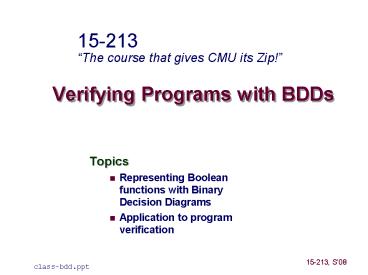Verifying Programs with BDDs - PowerPoint PPT Presentation
Title:
Verifying Programs with BDDs
Description:
Verifying Programs with BDDs. Topics. Representing Boolean functions with Binary ... absi. int abs(int x) { int mask = x 31; return (x ^ mask) ~mask 1; 6 ... – PowerPoint PPT presentation
Number of Views:46
Avg rating:3.0/5.0
Title: Verifying Programs with BDDs
1
Verifying Programs with BDDs
15-213The course that gives CMU its Zip!
- Topics
- Representing Boolean functions with Binary
Decision Diagrams - Application to program verification
15-213, S08
class-bdd.ppt
2
Verification Example
int abs(int x) int mask xgtgt31 return (x
mask) mask 1
int test_abs(int x) return (x lt 0) ? -x x
- Do these functions produce identical results?
- How could you find out?
- How about exhaustive testing?
3
More Examples
int addXY(int x, int y) return xy
int addYX(int x, int y) return yx
?
int mulXY(int x, int y) return xy
int mulYX(int x, int y) return yx
?
4
How Can We Verify Programs?
- Testing
- Exhaustive testing not generally feasible
- Currently, programs only tested over small
fraction of possible cases - Formal Verification
- Mathematical proof that code is correct
- Did Pythagoras show that a2 b2 c2 by testing?
c
a
b
5
Bit-Level Program Verification
int abs(int x) int mask xgtgt31 return (x
mask) mask 1
- View computer word as 32 separate bit values
- Each output becomes Boolean function of inputs
6
Extracting Boolean Representation
Straight-Line Evaluation
int bitOr(int x, int y) return (x y)
int test_bitOr(int x, int y) return x y
- Do these functions produce identical results?
v5 x y
t v4 v5
7
Tabular Function Representation
- List every possible function value
- Complexity
- Function with n variables
8
Algebraic Function Representation
x2 x3
x1 x3
- f(x1, x2, x3) (x1 x2) x3
- Boolean Algebra
- Complexity
- Representation
- Determining properties of function
- E.g., deciding whether two expressions are
equivalent
9
Tree Representation
Truth Table
Decision Tree
- Vertex represents decision
- Follow green (dashed) line for value 0
- Follow red (solid) line for value 1
- Function value determined by leaf value
- Complexity
10
Ordered Binary Decision Diagrams
Initial Tree
Reduced Graph
(x1 x2) x3
- Canonical representation of Boolean function
- Two functions equivalent if and only if graphs
isomorphic - Can be tested in linear time
- Desirable property simplest form is canonical.
11
Example Functions
12
More Complex Functions
- Functions
- Add 4-bit words a and b
- Get 4-bit sum S
- Carry output bit Cout
- Shared Representation
- Graph with multiple roots
- 31 nodes for 4-bit adder
- 571 nodes for 64-bit adder
- Linear growth!
13
Symbolic Execution
(3-bit word size)
14
Symbolic Execution (cont.)
15
Counterexample Generation
Straight-Line Evaluation
int bitOr(int x, int y) return (x y)
int bitXor(int x, int y) return x y
- Find values of x y for which these programs
produce different results
v5 x y
t v4 v5
16
Symbolic Execution
17
Performance Good
int addXY(int x, int y) return xy
int addYX(int x, int y) return yx
18
Performance Bad
int mulXY(int x, int y) return xy
int mulYX(int x, int y) return yx
19
Why Is Multiplication Slow?
- Multiplication function intractable for BDDs
- Exponential growth, regardless of variable
ordering
Node Counts
Bits Add Mult
4 21 155
8 41 14560
Multiplication-4
Add-4
20
What if Multiplication were Easy?
int factorK(int x, int y) int K XXXX...X
int rangeOK 1 lt x x lt y int
factorOK xy K return !(rangeOK
factorOK)
int one(int x, int y) return 1
21
Dealing with Conditionals
int abs(int x) int r if (x lt 0) r
-x else r x return r
- During Evaluation, Keep Track of
- Current Context Under what condition would code
be evaluated - Definedness (for each variable)
- Has it been assigned a value
22
Dealing with Loops
Unrolled
int ilog2(unsigned x) int r -1 while (x)
r x gtgt 1 return r
int ilog2(unsigned x) int r -1 if (x)
r x gtgt 1 else return r if (x)
r x gtgt 1 else return r . . . if
(x) r x gtgt 1 else return r
error()
- Unroll
- Turn into bounded sequence of conditionals
- Default limit 33
- Signal runtime error if dont complete within
limit
23
Evaluation
- Strengths
- Provides 100 guarantee of correctness
- Performance very good for simple arithmetic
functions - Weaknesses
- Important integer functions have exponential
blowup - Not practical for programs that build and operate
on large data structures
24
Some History
- Origins
- Lee 1959, Akers 1976
- Idea of representing Boolean function as BDD
- Hopcroft, Fortune, Schmidt 1978
- Recognized that ordered BDDs were like finite
state machines - Polynomial algorithm for equivalence
- Bryant 1986
- Proposed as useful data structure efficient
algorithms - McMillan 1987
- Developed symbolic model checking
- Method for verifying complex sequential systems
- Bryant 1991
- Proved that multiplication has exponential BDD
- No matter how variables are ordered































